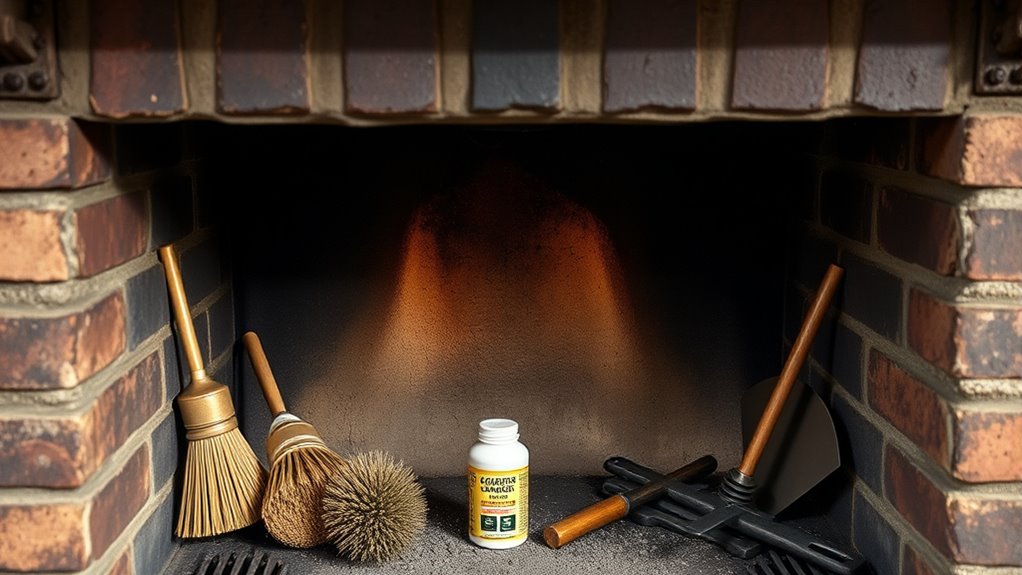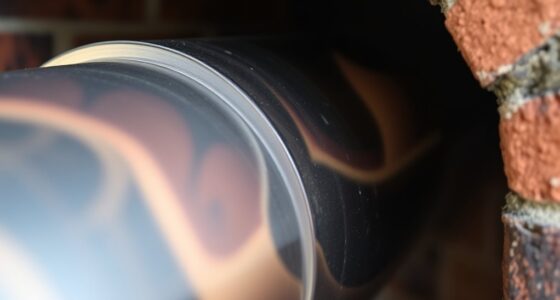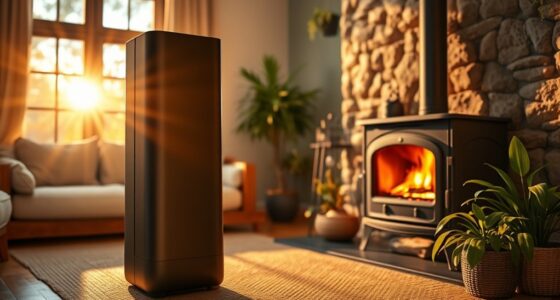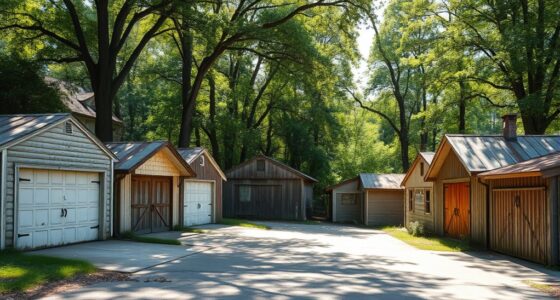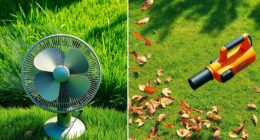To prevent chimney fires caused by creosote buildup, you should regularly inspect and clean your chimney, especially during peak burning seasons. Use dry, seasoned wood and make sure proper insulation to maintain high temperatures that reduce creosote formation. Install a chimney cap to keep debris out and schedule professional cleanings at least once a year. Staying on top of maintenance and recognizing signs of buildup will keep your chimney safe—continue to learn effective tips for keeping your chimney fire-free.
Key Takeaways
- Maintain proper chimney insulation to keep high temperatures and prevent creosote condensation.
- Use seasoned, dry wood to reduce smoke and slow creosote buildup.
- Regularly inspect and clean your chimney to remove creosote deposits and identify damage early.
- Install a chimney cap to block debris, moisture, and animals that can worsen creosote accumulation.
- Schedule professional chimney inspections annually, especially with frequent use, to ensure safety and proper maintenance.
How Creosote Forms Inside Your Chimney

Creosote forms inside your chimney when smoke and gases from burning wood cool down and condense on the inner walls. As this happens, the flue material’s properties play a significant role in how quickly creosote develops. If your chimney lacks proper insulation, heat escapes, causing the smoke to cool prematurely and increasing creosote buildup. Conversely, good chimney insulation helps maintain higher temperatures, reducing the chances of creosote condensation. The type of flue material also matters; some materials resist creosote adhesion better than others, making cleaning easier. When the gases cool too rapidly, the condensed creosote creates a sticky, tar-like substance that sticks to the inner walls. Over time, this buildup thickens, raising the risk of chimney fires if not properly managed. Additionally, understanding chimney maintenance practices can help you prevent dangerous creosote accumulation and ensure safe operation of your fireplace or stove. Proper airflow and ventilation also influence creosote formation by affecting how quickly gases exit and cool within the chimney. Ensuring consistent combustion temperatures can further help reduce creosote buildup by promoting cleaner burning processes. Regularly inspecting and cleaning your chimney is essential for fire safety, especially if you burn wood frequently or have a large fireplace.
Recognizing the Signs of Creosote Buildup

You should watch for dark stains around your chimney’s flue, which can indicate creosote buildup. An unusual smoke smell inside your home is another sign that creosote may be accumulating. Recognizing these signs early helps you prevent dangerous chimney fires before they start. Additionally, regular chimney cleaning is essential to remove creosote deposits and ensure safe operation. Proper air purifier maintenance can also help reduce the risk of creosote buildup by maintaining optimal airflow and filtration. Maintaining proper ventilation can further minimize creosote accumulation and improve overall safety. In regions with a high demand for best restaurants, maintaining a clean and safe chimney is equally important for enjoying cozy meals during colder months. Incorporating vertical storage solutions for chimney tools and supplies can streamline your maintenance routine and keep your space organized.
Dark Stains Around Flue
Dark stains around your chimney’s flue are a clear sign that creosote has accumulated. These stains can affect your chimney’s aesthetics, making it look dirty and poorly maintained. A flue color change, especially to black or dark brown, often indicates creosote buildup. When creosote deposits coat the inside of the chimney, smoke and soot can seep through and stain the exterior. If you notice dark streaks or spots around the flue, it’s a sign you need to act. Ignoring these signs can increase the risk of chimney fires. Regular inspections and cleaning can prevent dangerous creosote buildup. Recognizing these visual cues early helps you maintain a safe, efficient chimney and keeps your home protected from potential fire hazards. Additionally, using proper chimney cleaning methods can help effectively remove creosote deposits before they become hazardous.
Unusual Smoke Odor
Unusual smoke odors around your fireplace or chimney are often a warning sign that creosote buildup is occurring inside. If you notice an unusual smoke or a distinct chimney odor lingering even when the fire isn’t burning, it could indicate creosote accumulation. This buildup restricts airflow and causes smoke to escape improperly, leading to unpleasant smells. Pay attention to any persistent or strange smoke patterns, especially if the smell seems stronger or different than usual. Ignoring these signs can increase the risk of chimney fires. Regular inspections and cleanings can help prevent creosote buildup and eliminate unusual smoke or chimney odors. If you detect these warning signs, it’s best to have a professional assess your chimney before further issues develop.
The Risks Associated With Excessive Creosote

Excessive creosote buildup in your chimney considerably increases the risk of a fire. When creosote accumulates, it can ignite unexpectedly, causing dangerous chimney fires. Poor vent pipe maintenance worsens this risk by restricting airflow, trapping heat, and allowing creosote to cling more easily to the chimney walls. Additionally, inadequate chimney insulation can cause uneven heat distribution, increasing the likelihood of creosote ignition. Over time, these hazards weaken the chimney’s structure and can lead to dangerous smoke leaks or chimney collapse. Regular inspections and cleaning are essential to prevent buildup. Keeping your chimney well-maintained, ensuring proper vent pipe upkeep, and checking insulation levels help mitigate these risks, keeping your home safe and your fireplace functioning efficiently. Using environmentally friendly, efficient wood stove models can also reduce creosote formation by promoting complete combustion and lower emissions. Proper chimney inspections and timely cleanings are crucial for preventing dangerous creosote accumulation.
Essential Tools for Chimney Cleaning

To effectively prevent chimney fires caused by creosote buildup, having the right tools for cleaning is indispensable. First, a sturdy soot brush is critical for scrubbing away creosote and soot inside the flue. Choose a brush with stiff bristles that fit your chimney’s diameter to guarantee thorough cleaning. Additionally, a chimney cap is essential; it prevents debris and animals from entering, reducing buildup and making your cleaning process easier. A chimney brush pole extends your reach, allowing you to access high or hard-to-reach areas safely. Gloves and a dust mask protect you from soot and dust particles during cleaning. Investing in these necessary tools ensures you can maintain your chimney effectively, reducing the risk of fire caused by creosote accumulation. Proper maintenance also involves understanding Mazda Tuning techniques to optimize performance and safety, which can be metaphorically applied to chimney upkeep by ensuring all components function correctly. Regular inspections and Bluetooth compatibility checks can help identify potential issues early, similar to how maintaining headphones prevents malfunctions.
Step-by-Step Guide to Removing Creosote Safely
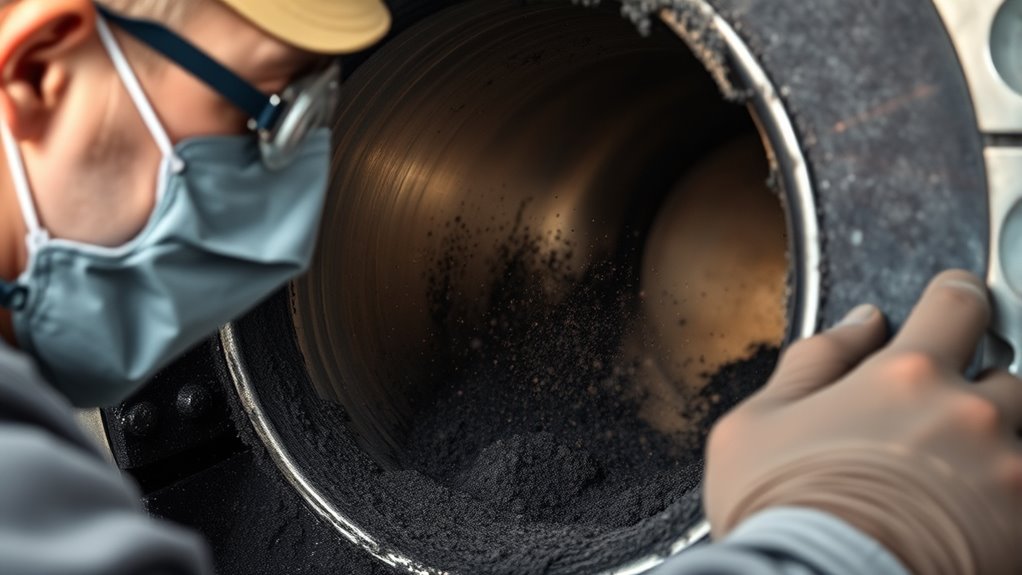
Before you start removing creosote, make sure you’re prepared with the right safety gear and tools. Safety is essential—wear gloves, goggles, a dust mask, and a protective suit. Gather your chimney brush, extension rods, and a sturdy ladder. Check that your chimney cap maintenance is up to date, as a well-maintained cap prevents debris from falling in. Follow fire safety protocols strictly—never work alone, and keep a fire extinguisher nearby. Keep these tips in mind:
- Confirm the chimney is cool before starting
- Use a sturdy, well-placed ladder for stability
- Protect your floors and furniture from soot
- Keep your tools organized for efficiency
- Stay alert for signs of damage during cleaning
- Remember that sound healing science suggests that vibrations and frequencies can influence cellular health, underscoring the importance of a thorough cleaning to maintain your chimney’s proper function. Additionally, ensuring your chimney is free of creosote buildup can help prevent chimney fires, which pose serious safety risks.
Best Practices for Preventing Creosote Accumulation
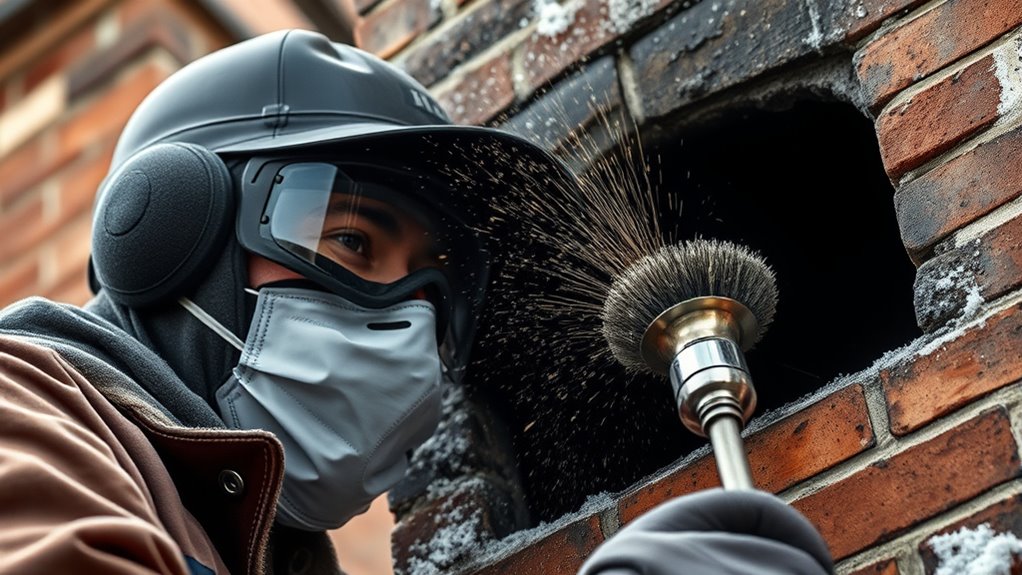
Regular maintenance and mindful practices are key to preventing creosote buildup in your chimney. Ensure your chimney is properly insulated; good insulation maintains consistent temperatures that reduce creosote formation. Regularly check and seal vents to prevent leaks and drafts that can cause inefficient burning. Use seasoned, dry wood to minimize excess smoke and creosote deposits. Additionally, inspect your chimney for cracks or gaps and seal them promptly to improve airflow and combustion. Proper vent sealing keeps smoke and creosote contained, reducing buildup. Consider using a chimney cap to prevent debris and moisture from entering. Implementing these practices consistently helps maintain a cleaner chimney and reduces fire risks. Maintaining optimal combustion efficiency is essential for reducing creosote accumulation over time. Ensuring proper airflow and complete combustion can significantly decrease creosote deposits and enhance safety. Regular chimney inspections by a professional can identify early signs of buildup before they become hazardous.
When to Call a Professional Chimney Sweep
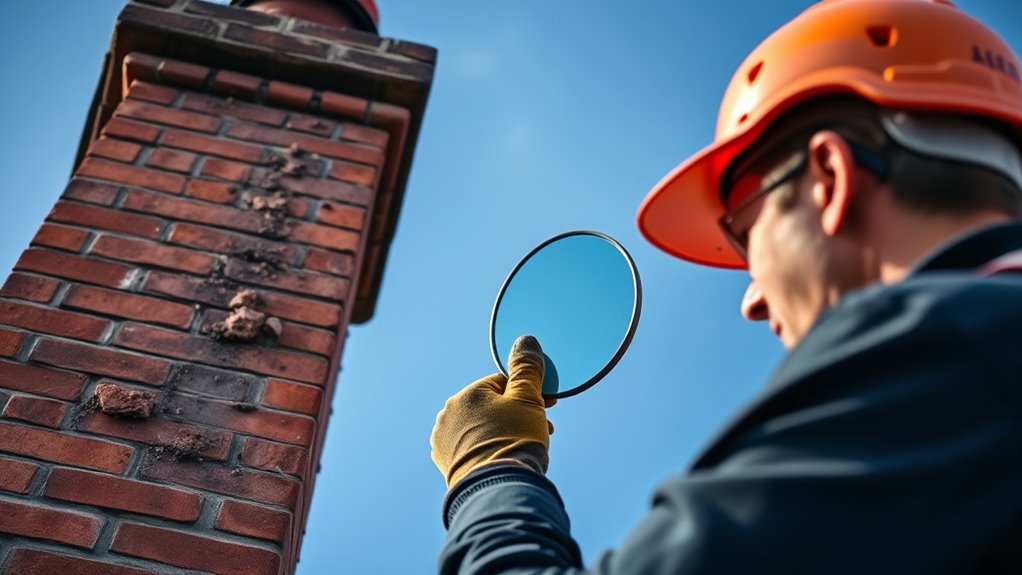
If you notice smoke or odors lingering after a fire, it’s time to call a professional. Strange noises or visible blockages also indicate you need expert help. Regular inspections can catch issues early before they become serious hazards. Additionally, maintaining good ventilation in the chimney can help prevent the buildup of creosote and reduce fire risk. Proper ventilation practices are essential for fire safety and overall chimney health. Implementing data-driven strategies for regular cleaning schedules can further minimize hazards and ensure safety.
Signs of Serious Blockage
A serious blockage in your chimney can pose significant safety risks, making it crucial to recognize the warning signs early. If you notice persistent smoke coming into your home, unusual odors, or difficulty lighting a fire, these could indicate a dangerous buildup or ventilation issues. Pay close attention to your chimney’s performance—if fires burn inefficiently or produce excessive smoke, it’s a red flag. Sometimes, improper chimney design can trap creosote or debris, worsening blockages.
You should call a professional chimney sweep if you experience:
- Smoke backing up into your living space
- A strong, persistent smell of soot or fumes
- Visible creosote or debris around the chimney cap
- Difficulty maintaining a steady fire
- Unusual sounds or vibrations when burning
- High levels of creosote accumulation can significantly increase the risk of chimney fires and should be addressed promptly.
When to Schedule Routine Inspection
Scheduling routine chimney inspections guarantees your system stays safe and efficient. How often you should call a professional depends on your chimney’s materials and usage. If you use your fireplace frequently or have a masonry chimney, scheduling an inspection annually is recommended. For metal chimneys or less frequent use, every two years might suffice. Regular inspections help identify creosote buildup, cracks, or damage that could lead to fires. Even if you notice no issues, routine checkups ensure your chimney remains in good condition and adheres to safety standards. Ignoring inspection frequency can lead to overlooked hazards, increasing your risk of chimney fires. Trust a qualified chimney sweep to evaluate your system’s condition and recommend maintenance to keep your home safe. Best Beaches offer scenic views and outdoor experiences that can also benefit your overall well-being by promoting relaxation and stress relief. Additionally, understanding the importance of chimney safety and proper maintenance can prevent dangerous creosote buildup that is a common cause of fires.
Tips for Maintaining a Safe and Efficient Chimney
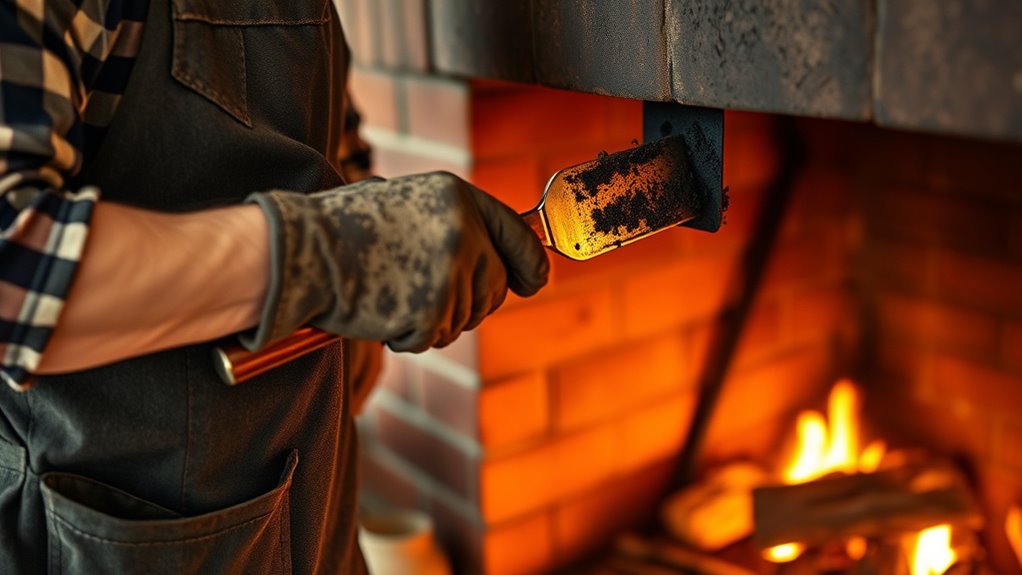
Regularly inspecting and cleaning your chimney is essential for maintaining safety and efficiency. A well-designed chimney ensures proper airflow and reduces creosote buildup, while the right fireplace accessories help you monitor and maintain your system. To keep your chimney in top shape, consider these tips:
- Check for blockages or debris that could cause dangerous backups
- Use a chimney cap to prevent animal intrusion and debris accumulation
- Ensure proper chimney design to promote efficient smoke venting
- Regularly clean your fireplace accessories, like dampers and vents
- Schedule professional inspections to catch issues early
These simple steps not only protect your home but also keep your fireplace burning safely and efficiently. Staying proactive with maintenance gives you peace of mind and maximizes your comfort during cozy nights.
Seasonal Cleaning and Inspection Recommendations
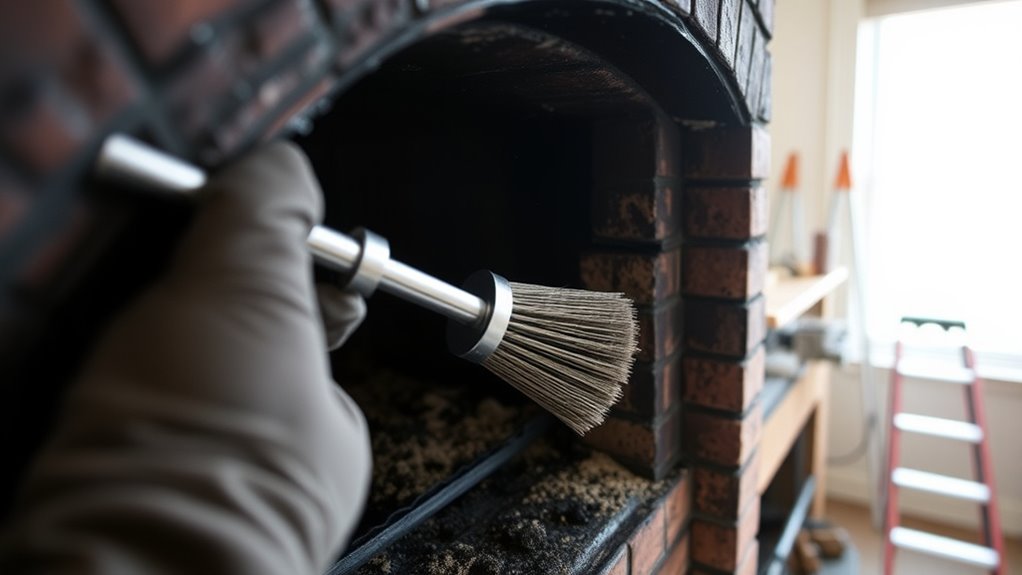
To keep your chimney safe and functioning efficiently, it’s essential to perform seasonal cleaning and inspections. Start by examining your chimney’s design; ensure there are no obstructions or cracks that could trap creosote or allow smoke to escape improperly. During inspections, check the insulation effectiveness around the chimney, as poor insulation can lead to heat transfer issues and increase fire risks. Regular cleaning removes creosote buildup, reducing the chance of fire. Pay attention to the chimney cap and flashing for damage or blockages. Scheduling professional inspections at least once a year guarantees you catch potential problems early. Proper maintenance aligned with your chimney’s design and insulation effectiveness keeps your fireplace safe and efficient throughout every season.
Frequently Asked Questions
How Often Should I Schedule Professional Chimney Inspections?
You should schedule professional chimney inspections at least once a year to guarantee safety and proper function. During the inspection, professionals will check your chimney cap installation and assess flue lining maintenance. If you use your fireplace frequently or notice issues like smoke backdrafts, consider more regular visits. Regular inspections help catch problems early, prevent creosote buildup, and keep your chimney safe and efficient year-round.
Can Creosote Buildup Occur With Gas Fireplaces?
Imagine a quiet forest, but even in peaceful woods, undergrowth can hide dangers. Similarly, creosote formation isn’t just a concern for wood-burning chimneys; gas fireplaces can develop deposits over time. Gas fireplace maintenance is vital because creosote buildup can occur, especially if the ventilation isn’t proper. Regular inspections and cleaning help prevent buildup, ensuring your gas fireplace remains safe and efficient, just like clearing a path through the woods.
What Are Eco-Friendly Methods to Clean Creosote?
You can clean creosote using eco-friendly methods by choosing biodegradable cleaners that are safe for the environment. Use natural scrubbing tools like a stiff brush or a scrub pad to gently remove the buildup. Combine these with a vinegar or baking soda solution for effective, chemical-free cleaning. Regularly maintaining your chimney with these eco-conscious methods helps prevent dangerous creosote accumulation while protecting the planet.
Are There DIY Techniques to Prevent Creosote Formation?
Oh, sure, you can easily prevent creosote buildup with some DIY maintenance—if you ignore the importance of proper burning techniques! In reality, the best creosote prevention involves regular inspections, using seasoned wood, and ensuring good airflow. Simple DIY steps like burning only dry wood, avoiding smoldering fires, and keeping your chimney clean help reduce creosote formation. Remember, a little effort here keeps fires at bay—so don’t skip your routine maintenance!
How Does Chimney Design Affect Creosote Accumulation?
You should know that chimney design impacts creosote buildup considerably. A chimney with a smooth, straight shape allows better airflow, reducing creosote accumulation. The flue diameter also matters; if it’s too narrow, smoke cools quickly, increasing creosote formation. Conversely, an appropriately sized flue promotes efficient drafting, minimizing creosote buildup. Proper design choices help your chimney stay cleaner and safer, making maintenance easier and reducing fire risks.
Conclusion
While you might think lighting fires keeps your home warm and cozy, neglecting chimney maintenance can turn that comfort into a fiery nightmare. Creosote silently sneaks in, building up like an unwelcome guest, waiting to ignite at the worst moment. So, enjoy your fireplace responsibly—clean it regularly, and don’t let that dark, sticky layer turn your dream home into a smoky inferno. Irony’s sweet—sometimes, prevention is the hottest safeguard you’ve got.

